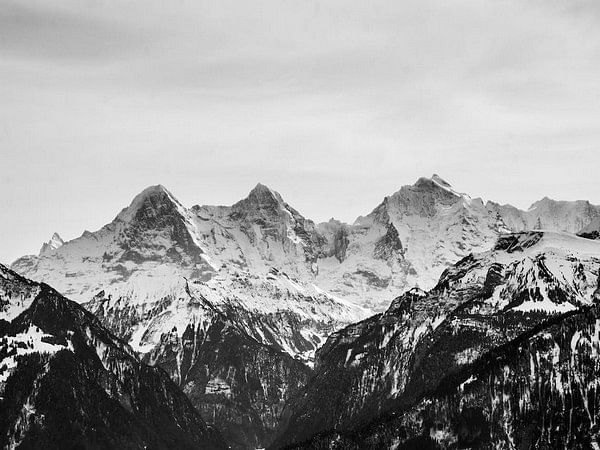Washington [US], October 27 (ANI): Geoscientists examined rocks in mountain ranges to determine how they originally travelled lower into the depths and then back up to the surface.
This history of burial and exhumation shed light on plate tectonics and mountain formation. Certain rocks and plates that sink deep into the Earth’s interior are converted into other sorts due to the enormous pressure that exists there During this UHP metamorphism (UHP: Ultra High Pressure), silica (SiO2) in the rock, for example, transforms into coesite, also known as the UHP polymorph of SiO2. Although it is still silica chemically, the crystal lattices are more closely packed and thus denser.
When the plates rise from the depths, the UHP rocks rise to the surface and can be found in particular areas of the mountains. Their mineral composition reveals the forces to which they were subjected during their vertical trip through the Earth’s interior. Using lithostatic pressure as a unit of measurement, pressure and depth can be correlated: the higher the pressure, the deeper the rocks originally lay.
Until recently, scientists considered that UHP rocks were buried at a depth of 120 kilometres. They then returned to the surface, accompanied by the plates. The ambient pressure declined at a steady rate, i.e. statically, during the process.
However, a new study by Goethe University Frankfurt and the universities of Heidelberg and Rennes (France) calls this assumption of a long, continuous ascent into question. Among those involved in the study on the part of Goethe University Frankfurt were first author Cindy Luisier, who came to the university on a Humboldt Research Fellowship, and Thibault Duretz, head of the Geodynamic Modeling Working Group at the Department of Geosciences.
The research team analyzed whiteschists from the Dora Maira Massif in the Western Alps, Italy. “Whiteschists are rocks that formed as a result of the UHP metamorphosis of a hydrothermally altered granite during the formation of the Alps,” explained Duretz. “What is special about them is the large amount of coesite. The coesite crystals in the whiteschist are several hundred micrometres in size, which makes them ideal for our experiments.”
The piece of whiteschist from the Dora Maira Massif contained pink garnets in a silvery-white matrix composed of quartz and other minerals. “The rock has special chemical and thus mineralogical properties,” said Duretz. Together with the team, he analyzed it by first cutting a very thin slice about 50 micrometres thick and then glueing it onto the glass. In this way, it was possible to identify the minerals under a microscope. The next step was computer modelling of specific, particularly interesting areas.
These areas were silica particles surrounded by the grains of pink garnet, in which two SiO2 polymorphs had formed. One of these was coesite, which had formed under very high pressure (4.3 gigapascals). The other silica polymorph was quartz, which lay like a ring around the coesite. It had formed under much lower pressure (1.1 gigapascals).
The whiteschist had evidently first been exposed to very high and then much lower pressure. There had been a sharp decrease in pressure or decompression. The most important discovery was that spoke-shaped cracks radiated from the SiO2 inclusions in all directions: the result of the phase transition from coesite to quartz. The effect of this transition was a large change in volume, and it caused extensive geological stresses in the rock. These made the garnet surrounding the SiO2 inclusions fracture.
“Such radial cracks can only form if the host mineral, the garnet, stays very strong,” explained Duretz. “At such temperatures, garnet only stays very strong if the pressure drops very quickly.”
On a geological timescale, “very quickly” means in thousands to hundreds of thousands of years. In this “short” period, the pressure must have dropped from 4.3 to 1.1 gigapascals. The garnet would otherwise have creeped viscously to compensate for the change in volume in the SiO2 inclusions, instead of forming cracks.
According to Duretz, the previous assumption that UHP rock reaches a depth of 120 kilometres seems less probable in view of this rapid decompression because the ascent from such a depth would take place over a long period of time, which does not equate with the high decompression rate, he said.
“We rather presume that our whiteschist lay at a depth of only 60 to 80 kilometres,” says the geoscientist. And the processes underway in Earth’s interior could also be quite different than assumed in the past. That rock units move continuously upwards over great distances, from a depth of 120 kilometres to the surface, also seems less probable than previously thought.
“Our hypothesis is that rapid tectonic processes took place instead, which led to minimal vertical plate displacements.” We can imagine it like this, he said: The plates suddenly jerked upwards a little bit in Earth’s interior – and as a result, the pressure surrounding the UHP rock decreased in a relatively short time. (ANI)
This report is auto-generated from ANI news service. ThePrint holds no responsibility for its content.



